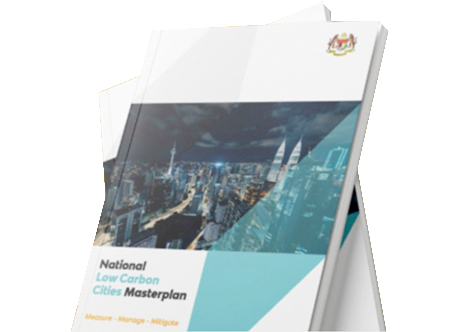About NLCCM
National Low Carbon Cities Masterplan (NLCCM) was launched on 13 July 2021 during the Malaysian Low Carbon Cities Conference (MYL3C) by the then Ministry of Environment and Water (KASA).

The NLCCM document was developed by the GTALCC Project (Green Technology Application for Low Carbon Cities) sponsored by the United Nations Development Program (UNDP) – Global Environment Facility (GEF) and implemented by the Ministry of Natural Resources, Environment and Climate Change (NRECC ) with the Sustainable Energy Development Authority Malaysia (SEDA Malaysia) as the main consultantwas mandated by NRECC to execute the NLCCM programme nationwide onwards.
The NLCCM document was developed by the GTALCC Project (Green Technology Application for Low Carbon Cities) sponsored by the United Nations Development Program (UNDP) – Global Environment Facility (GEF) and implemented by the Ministry of Natural Resources, Environment and Climate Change (NRECC ) with the Sustainable Energy Development Authority Malaysia (SEDA Malaysia) as the main consultantwas mandated by NRECC to execute the NLCCM programme nationwide onwards.
NLCCM used 3M approach which Measurement, Management and Mitigation. 3 key drives are needed to effect the transformation change which consist of Governance and Implementation framework, urban planning and community participation. In order to assist in providing greater impact, 3 key enablers are funding and capacity building, data collection and analyst, and built environment and physical infrastructure.
Several main documents which are Climate Change Policy 2009, National Green Technology Policy 2009, Green Technology Master Plan 2017 has been the supporting documents for NLCCM. This is in the hope to reduce the intensity of greenhouse gas (GHG) emission across the economy by 45% based on the GDP in 2030, and to achieve net-zero GHG emission as early as 2050.
Summary of NLCCM Key Directions action plans are as follows:-
Streamline line and Integrate Related Low Carbon Policies and Regulations
Provide Funding and Financing to Facilitate Low Carbon Development
Strengthen the Institutional Framework and Implementation Mechanism at All Levels
Invest and Build Capacity to Act
Mainstream Low Carbon Urban Planning and Development
Improve Low Carbon Information and Data Management
Increase Community Participation in Low Carbon Development
Measure Low Carbon Performance
Develop Citywide/ Sectoral Development Strategies on Low Carbon
There are further 24 Key Directions which is listed as below
Key directions and key actions
KD1: Streamline and Integrate Related Low Carbon Policies and Regulations
- Action 1.1 Align Existing Regulation and Laws to Support Low Carbon Cities Development
- Action 1.2 Align National Climate Change Policy (NCCP) to Support Low Carbon Cities Development
- Action 1.3 Establish Absolute Carbon Reduction Targets for Targeted Cities (2021-2050)
- Action 1.4 Establish Policies to Enable Top Down Approach for Low Carbon Implementation at State Level
- Action 1.5 Integrate Low Carbon Guideline and Components into Existing and New Planning Development Documents
- Action 1.6 Promote Agriculture, Forestry and Other Land Uses (AFOLU) as Part of GHG Reduction Measures
- Action 1.7 Align Definition and Approach for Low Carbon Cities at All Levels
KD2: Strengthen the Institutional Framework and Implementation Mechanism at All
- Action 2.1 Improve the Governance and Implementation Structure at Federal and State Levels
- Action 2.2 Strengthen the Implementation Mechanism at the Ground Level
KD3: Mainstream Low Carbon Urban Planning and Development
- Action 3.1 Embed Low Carbon Elements in Urban Planning and Development
- Action 3.2 Develop Standard Guideline of GHG Emissions Reduction Strategies for Easy and Consistent Implementation at Ground Level
KD4: Increase Community Participation in Low carbon Development
- Action 4.1Nurture Active Participation and Awareness Through Effective Communication Plan
- Action 4.2 Use Education to Foster Human Behavioural Changes to Sustainable Practices
- Action 4.3 Create Specific Low Carbon Development Fund and Budget to Implement Low Carbon Programmes and Initiatives
- Action 4.4Create Alternative Funding to Finance Low Carbon Initiatives and Programmes at Local Level
KD7: Improve Low Carbon Information and Data Management
- Action 7.1Establish Proper and Efficient System of Data Collection and Management for GHG Inventory Purposes
- Action 7.2Develop Central Online System on GHG Emissions Reporting and Data Management to be Used at All Levels
KD8: Measure Low Carbon Performance
- Action 7.1Align Performance-Based Tools to Global Protocol for Community-Scale Greenhouse Gas Emission Inventories (GPC)
KD6: Invest and Build Capacity To Act
- Action 4.1Develop and Place Dedicated Officers at State and Local Levels to Increase Productivity and Create Holistic Manpower Support System
- Action 4.2Develop and Nurture Knowledge, Expertise and Skills in Low Carbon Development Area at State and Local Levels
KD9: Develop Citywide/Sectoral Development Strategies on Low Carbon
- Action 9.1Spatial Planning and Development
- Action 9.2Energy
- Action 9.3Transportation
- Action 9.4Waste
In order to execute NLCCM in the PBTs Local Authorities, 3 groups have been established with each group has their own target year to achieve the net-zero carbon level
Group 1
- Hang Tuah Jaya Municipal Council
- Iskandar Malaysia
- Iskandar Puteri City Council
- Johor Bahru City Council
- Kuala Lumpur City Hall
- Kulai Municipal Council
- Melaka Historic City Council
- Pasir Gudang City Council
- Penang Island City Council
- Petaling Jaya City Council
- Pontian District Council
- Putrajaya Corporation
- Seberang Perai City Council
- Sepang Municipal Council
- Shah Alam City Council
Group 2
- Alor Setar City Council
- Ampang Jaya Municipal Council
- Ipoh City Council
- Kajang Municipal Council
- Klang Municipal Council
- Kuching North City Hall
- Kuching South City Council
- Miri City Council
- Selayang Municipal Council
- Seremban City Council
- Subang Jaya City Council
Group 3
- Kota Bharu Municipal Council
- Kota Kinabalu City Hall
- Kuala Terengganu City Council
- Kuantan City Council
- Sandakan Municipal Council
- Sungai Petani Municipal Council
- Tawau Municipal Council
Besides the 33 cities mentioned above, all the cities in Malaysia at least need to do Planning, Capacity Building, Implementation and Monitoring in order to comply with the Key Directions and Key Actions stated earlier. To know more about NLCCM, click this link to read the main pdf document.

